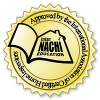
The International Association of Certified Home Inspectors
The International Association of Certified Home Inspectors strives to enhance the home inspection profession by offering valuable membership benefits, including free online training, certification, and business development.
Click to Learn More About the International Association of Certified Home Inspectors
Visit www.nachi.org and Join Now!